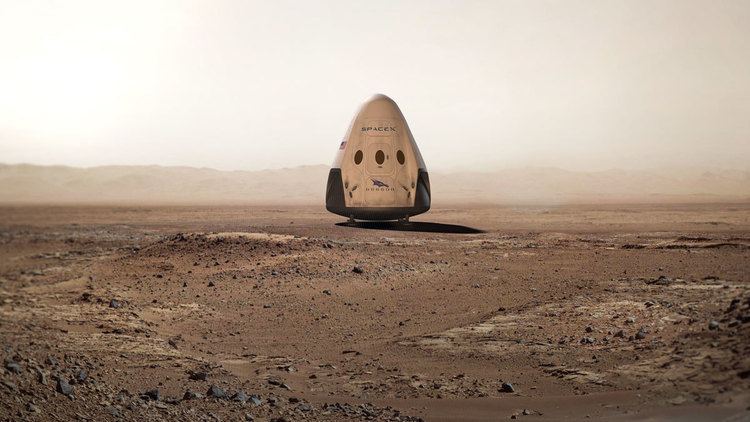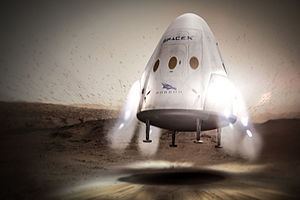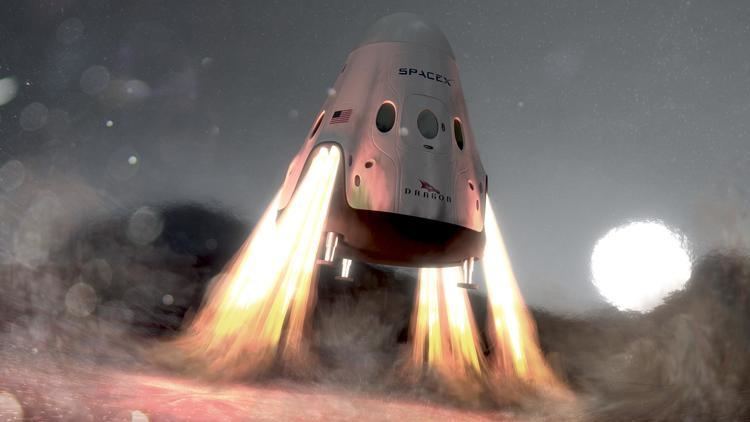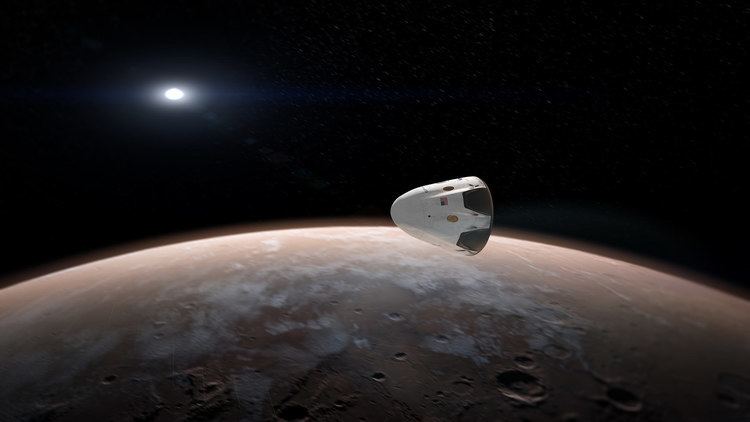Operator SpaceX Launch date 2020 (planned) Bus Dragon V2 | Payload mass Up to 1 t (2,200 lb) Rocket Falcon Heavy Manufacturer SpaceX | |
 | ||
Mission type Lander technology demonstrator; optional sample return Launch mass 6.5 t (14,000 lb) plus payload Similar Dragon V2, JCSAT‑2B, Thaicom 8, SpaceX Dragon, Amos‑6 | ||
Red Dragon is a planned unmanned SpaceX Dragon 2 capsule for low-cost Mars lander missions to be launched using Falcon Heavy rockets. This series of Mars missions will be technology pathfinders for the much larger SpaceX Mars colonization architecture that was announced in September 2016.
Contents

The primary objective of the first mission is to test techniques and technology to enter the Martian atmosphere with equipment a human crew could eventually use. An additional suggested use for the first mission calls for a sample return Mars rover to be delivered to the Martian surface. No payload has been announced.

The idea, conceived in 2011, was to propose it for funding in 2013 and 2015 as the United States NASA Discovery mission #13 for launch in 2022, but it was not submitted. On 27 April 2016 SpaceX announced that they will proceed with the robotic mission for a 2018 launch and NASA will be providing technical support. On 17 February 2017, SpaceX said the mission would be delayed to the 2020 launch window.

History

SpaceX worked with NASA's Ames Research Center in 2011 to produce a feasibility study for a mission that would search for evidence of life on Mars (biosignatures), past or present. SpaceX's Dragon version 1 capsule is used to ferry cargo, and Dragon 2 is planned to carry astronauts to and from the International Space Station in the future. The Red Dragon proposal called for modifications so it could be used to transport payload to Mars, land using retrorockets, and to become a precursor to a human mission to Mars.
2011 concept

The 2011 Red Dragon concept was conceived to use a modified 3.6-meter (12 ft) diameter Dragon module, with a mass of 6.5 tonnes (14,000 lb) and an interior volume of 7 cubic metres (250 cu ft) for up to 1 tonne (2,200 lb) of Mars-landed payload. The instruments were proposed to drill approximately 1.0 metre (3.3 ft) under ground to sample reservoirs of water ice known to exist in the shallow subsurface. The mission cost was projected in 2011 to be less than US$400 million, plus $150 million to $190 million for a launch vehicle and lander.
The goals for a NASA-funded mission, as originally proposed by NASA Ames Research Center, were:

2014 concept
A 2014 study of a potential 2021 NASA-funded Red Dragon mission suggested that it could offer a low-cost way for NASA to achieve a Mars sample return. In the concept, the Red Dragon capsule would be equipped with the system needed to return samples gathered on Mars, including a Mars Ascent Vehicle (MAV), an Earth Return Vehicle (ERV), and hardware to transfer the sample collected by a previously landed rover mission, such as NASA's planned Mars 2020 rover, to the ERV. The ERV would transfer the samples to high Earth orbit, where a separate future mission would pick up the samples and de-orbit to Earth. NASA did not fund either concept.
2016 concept
Over time, the Red Dragon concept has changed but the basic idea has remained: use a modified Dragon capsule to test developmental technologies with an uncrewed mission to Mars. The launch vehicle will be the Falcon Heavy, and the capsule will be a Dragon 2.
SpaceX is planning the initial Falcon Heavy rocket launch for early 2017, and Dragon 2 is scheduled to undergo flight tests in mid to late 2017. In April 2016, SpaceX reiterated their plan for a 2018 launch to Mars, but in February 2017 pushed this back to 2020.
The first Red Dragon mission remains a technology demonstrator and no payload has been announced. NASA will be involved in the mission at the level of technical interchange. In exchange for Martian entry, descent, and landing data from SpaceX, NASA will offer technical support and telemetry for the Red Dragon mission. As of 2016, NASA anticipates spending about $30 million of its public budgetary funds for employees and equipment to be used to monitor the mission.
Landing system
Thanks to its design integrating a robust heat shield and powerful thrusters, a modified Dragon 2 capsule may perform all the necessary entry, descent and landing (EDL) functions in order to deliver payloads of 1 tonne (2,200 lb) or more to the Martian surface without using a parachute; the use of parachutes is not feasible without significant vehicle modifications. It is calculated that the capsule's own aerodynamic drag may slow it sufficiently for the remainder of descent to be within the capability of the SuperDraco retro-propulsion thrusters. The retrorockets will slow the craft as it blazes into Mars' upper atmosphere at supersonic speed. 1900 kg of propellant would provide the Δv required for soft landing. This approach should allow the landing of the capsule at much higher Martian elevations than could be done with a parachute, and within 10 km (6.2 mi) landing accuracy. The engineering team continues developing options for payload integration with the Dragon capsule. Potential landing sites would be polar or mid-latitude sites with proven near-surface ice.
